Past Clean-up: Ensuring Safety And Security with Expert Medical Waste Removal
Past Clean-up: Ensuring Safety And Security with Expert Medical Waste Removal
Blog Article
Remain Ahead of Laws: Expert Guidance on Medical Waste Disposal
In a globe where the health care market is constantly progressing, it is necessary for clinical centers to remain in advance of laws when it comes to the proper disposal of clinical waste. From comprehending the different groups of clinical waste to applying the best collection and partition approaches, this conversation will certainly supply valuable insights and workable tips to assist facilities stay in advance of laws in the ever-changing landscape of clinical waste disposal.
Understanding Medical Waste Categories
Recognizing medical waste classifications is necessary for appropriate disposal and monitoring in health care centers. Clinical waste describes any kind of waste generated by healthcare activities that may pose a threat to public health or the atmosphere. It is essential to categorize medical waste precisely to guarantee its risk-free handling, disposal, transportation, and treatment.
There are a number of categories of clinical waste that medical care centers require to be acquainted with. The most common groups consist of infectious waste, pathological waste, sharps waste, pharmaceutical waste, and chemical waste. Each classification has particular standards and regulations for its proper administration and disposal.
Contagious waste includes materials contaminated with blood or various other bodily liquids, such as handwear covers, gowns, and laboratory societies. Pathological waste refers to human cells, organs, or body parts that need special handling and disposal. Sharps waste includes used needles, syringes, and other sharp objects that can cause injury and send infections. Drug waste makes up run out, extra, or polluted medicines that need mindful handling and disposal. Last but not least, chemical waste consists of solvents, disinfectants, and other chemical substances made use of in health care facilities.
Staying Up-To-Date With Regulatory Modifications
Staying present with governing adjustments is important for medical care facilities to ensure compliance and proper management of clinical waste disposal. medical waste removal services. With guidelines continuously progressing, it is necessary for health care facilities to remain updated to avoid fines, penalties, and potential injury to the atmosphere and public health
To remain ahead of regulatory modifications, healthcare centers ought to develop a system for tracking and tracking updates. This can be done by registering for regulatory e-newsletters, going to workshops and seminars, and actively joining industry organizations. Additionally, centers should mark an employee or team in charge of remaining notified and sharing information to pertinent stakeholders.
Regular interaction with governing firms is likewise vital. Healthcare centers should establish partnerships with local, state, and government firms to ensure they are aware of any type of changes in laws that may impact their waste administration practices. This can be done with regular conferences, involvement in public comment periods, and proactive involvement with regulative companies.
Additionally, health care centers must take into consideration partnering with waste monitoring companies that specialize in medical garbage disposal (medical waste disposal services with WasteX). These firms are typically fluent in the current guidelines and can give guidance and assistance to guarantee conformity
Applying Correct Collection and Partition Methods
To efficiently handle medical waste disposal, health care centers need to develop appropriate collection and partition techniques based on governing standards. Applying these approaches makes certain the safe handling and disposal of potentially dangerous materials, safeguards the environment, and reduces the check these guys out danger of injuries and infections to medical care employees and the public.
Correct collection and partition approaches entail making use of marked containers and labeling systems. Healthcare facilities must supply plainly labeled containers for different sorts of medical waste, such as sharps, infectious waste, pharmaceutical waste, and non-hazardous waste. These containers ought to be color-coded and clearly marked to prevent complication and promote easy identification.
Furthermore, health care centers need to train their staff on the correct treatments for gathering and segregating clinical waste. This includes enlightening them on the various kinds of waste, the ideal containers to utilize, and the value of following regulations and standards. Routine training sessions and refresher course training courses must be carried out to guarantee that personnel continue to be current on finest methods.
Moreover, health care facilities should develop a system for regular collection and disposal of medical waste. This might involve partnering with certified waste management firms that concentrate on medical garbage disposal. These firms will ensure that next the accumulated waste is moved and dealt with in conformity with regulative needs.
Choosing the Right Disposal Techniques

Incineration is just one of the most efficient and usual methods for throwing away particular kinds of medical waste, such as pathological waste and sharps. It includes the regulated combustion of waste at heats, decreasing it to ash. Nonetheless, incineration can release damaging toxins right into the air and contribute to air pollution.

Chemical treatment includes the usage of chemicals to decontaminate and neutralize the waste. Microwave treatment uses microwave energy to warmth and disinfect the waste.
Making Certain Conformity With Documents and Training
After meticulously considering the appropriate disposal methods for medical waste, healthcare centers have to make certain conformity with regulations and minimize ecological impact by executing effective documentation and training treatments. This action is critical in keeping a sustainable and safe setting for both medical care employees and the public.

Health care workers that handle clinical waste ought to receive appropriate training on waste partition, dealing with, and disposal treatments. By supplying thorough training, healthcare centers can equip their team to make informed choices and minimize the risk of improper medical waste disposal services with WasteX waste disposal.
Final Thought
Finally, staying in advance of laws in clinical waste disposal is crucial for healthcare centers. medical waste removal near me. Comprehending the different categories of medical waste, staying upgraded with governing changes, applying correct collection and partition approaches, picking the appropriate disposal methods, and making sure conformity through documents and training are all important actions. By following these standards, healthcare organizations can successfully dispose and manage of clinical waste in a accountable and safe fashion
From recognizing the different groups of medical waste to applying the ideal collection and segregation techniques, this discussion will certainly provide workable tips and useful insights to assist centers stay in advance of regulations in the ever-changing landscape of medical waste disposal. - medical waste disposal services with WasteX
The most common classifications consist of transmittable waste, pathological waste, sharps waste, pharmaceutical waste, and chemical waste. Healthcare facilities ought to offer plainly classified containers for various kinds of clinical waste, such as sharps, infectious waste, pharmaceutical waste, and non-hazardous waste. Healthcare facilities must develop a detailed system to tape and track all facets of clinical waste disposal, consisting of types of waste produced, quantities, and disposal methods used. Healthcare workers that handle clinical waste needs to obtain ideal training on waste partition, taking care of, and disposal treatments.
Report this page